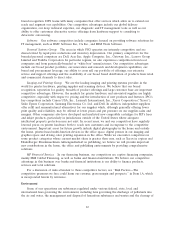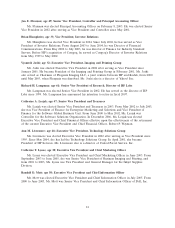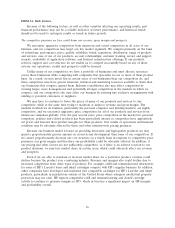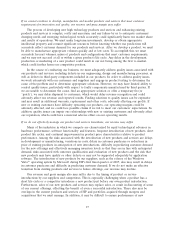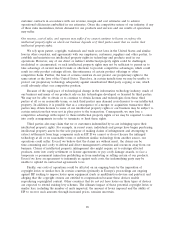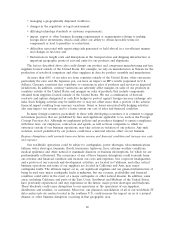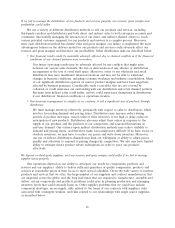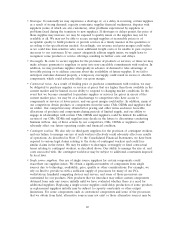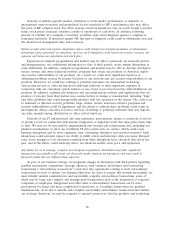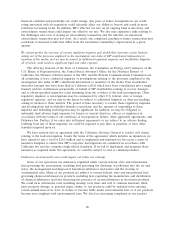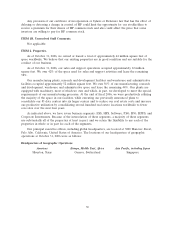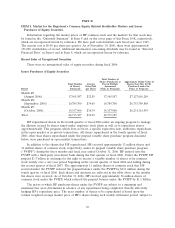HP 2006 Annual Report Download - page 26
Download and view the complete annual report
Please find page 26 of the 2006 HP annual report below. You can navigate through the pages in the report by either clicking on the pages listed below, or by using the keyword search tool below to find specific information within the annual report.•Shortages. Occasionally we may experience a shortage of, or a delay in receiving, certain supplies
as a result of strong demand, capacity constraints, supplier financial weaknesses, disputes with
suppliers (some of which are also customers), other problems experienced by suppliers or
problems faced during the transition to new suppliers. If shortages or delays persist, the price of
these supplies may increase, we may be exposed to quality issues or the supplies may not be
available at all. We may not be able to secure enough supplies at reasonable prices or of
acceptable quality to build products or provide services in a timely manner in the quantities or
according to the specifications needed. Accordingly, our revenue and gross margin could suffer
as we could lose time-sensitive sales, incur additional freight costs or be unable to pass on price
increases to our customers. If we cannot adequately address supply issues, we might have to
reengineer some products or service offerings, resulting in further costs and delays.
•Oversupply. In order to secure supplies for the provision of products or services, at times we may
make advance payments to suppliers or enter into non-cancelable commitments with vendors. In
addition, we may purchase supplies strategically in advance of demand to take advantage of
favorable pricing or to address concerns about the availability of future supplies. If we fail to
anticipate customer demand properly, a temporary oversupply could result in excess or obsolete
components, which could adversely affect our gross margin.
•Contractual terms. As a result of binding price or purchase commitments with vendors, we may
be obligated to purchase supplies or services at prices that are higher than those available in the
current market and be limited in our ability to respond to changing market conditions. In the
event that we become committed to purchase supplies or services for prices in excess of the
current market price, we may be at a disadvantage to competitors who have access to
components or services at lower prices, and our gross margin could suffer. In addition, many of
our competitors obtain products or components from the same CMs, ODMs and suppliers that
we utilize. Our competitors may obtain better pricing and other terms and more favorable
allocations of products and components during periods of limited supply, and our ability to
engage in relationships with certain CMs, ODMs and suppliers could be limited. In addition,
certain of our CMs, ODMs and suppliers may decide in the future to discontinue conducting
business with us. Any of these actions by our competitors, CMs, ODMs or suppliers could
adversely affect our future operating results and financial condition.
•Contingent workers. We also rely on third-party suppliers for the provision of contingent workers,
and our failure to manage our use of such workers effectively could adversely affect our results
of operations. As described in Note 17 to the Consolidated Financial Statements, we have been
exposed to various legal claims relating to the status of contingent workers and could face
similar claims in the future. We may be subject to shortages, oversupply or fixed contractual
terms relating to contingent workers, as described above. Our ability to manage the size of, and
costs associated with, the contingent workforce may be subject to additional constraints imposed
by local laws.
•Single source suppliers. Our use of single source suppliers for certain components could
exacerbate our supplier issues. We obtain a significant number of components from single
sources due to technology, availability, price, quality or other considerations. For example, we
rely on Intel to provide us with a sufficient supply of processors for many of our PCs,
workstations, handheld computing devices and servers, and some of those processors are
customized for our products. New products that we introduce may utilize custom components
obtained from only one source initially until we have evaluated whether there is a need for
additional suppliers. Replacing a single source supplier could delay production of some products
as replacement suppliers initially may be subject to capacity constraints or other output
limitations. For some components, such as customized components and some of the processors
that we obtain from Intel, alternative sources may not exist or those alternative sources may be
22


